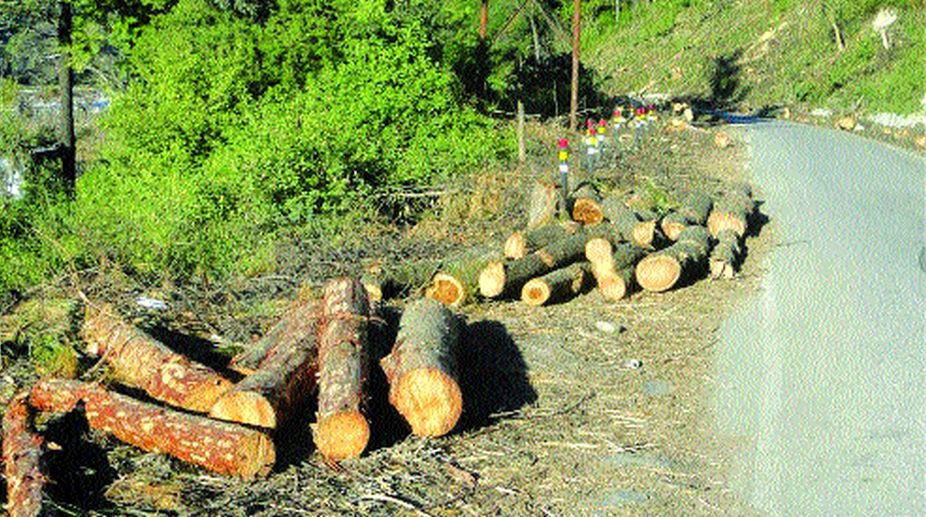At a time that ecologists are re-emphasising the need to protect forests and trees, thousands of trees are being mercilessly chopped in the sensitive eco-zone of the catchment areas of the Ganga river in the Himalayan region. This is being done in the name of speeding up ill-planned construction work taken up without consulting local people.
People familiar with the local terrain say that most of the loss of trees could have been avoided if only a participatory decentralised approach had been adopted and possibilities of saving trees were carefully considered with inputs from well-informed local people.
Advertisement
Tens of thousands of trees in various Himalayan regions have been cut or marked for felling or otherwise threatened due to hastily and badly planned highway expansion and widening, hydel and tunnel projects. As Radha Bhatt, a senior Gandhian social worker says, the area where a lot of trees are being felled today was once the area of the Chipko movement in the Garhwal hills. At that time even though the number of trees targeted was smaller, the Government had responded to the demands of the Chipko movement to stop felling of trees.
As a young reporter I reported on the Chipko movement from Garhwal in the 1970s. I remember vividly the excitement of being in remote forests to meet villagers who were hugging trees to prevent them from being cut. However, the Union government was also sensitive in the sense that once the issue had been highlighted it agreed to cancel the auction of trees that had already taken place and so even the trees marked for felling in forests like Advani and Salet (Tehri Garhwal district) were saved.
This time around the situation seems to be different. Even though the extent of damage is much greater there seems to be a lack of sensitivity in responding to those who are opposing the large-scale actual and planned felling of trees.
Suresh Bhai, a senior Gandhian social activist, is based in Uttarkashi district of Uttarakhand. He was earlier involved in the Raksha Sutra movement for protecting trees. He has been playing a leading role in drawing attention to the recent large-scale felling of trees. He makes three points.
Firstly, he says that the government’s estimates of the likely felling due to the highways widening project, particularly relating to four leading pilgrimages, is about 46,000 trees of which about half have already been felled. Given the scale of tree-slaughter at least the Union Environment Ministry should immediately order a high-level inquiry on the extent of damage.
He says that the felling of one tree on these slopes damages about ten smaller growth trees as well as neighbouring trees. The careless ways of disposing rubble are also harming trees as well as rivers, he says. Hence, against the official estimate of 25,000 or so felled trees he says that about ten times this number or around 250,000 trees have been damaged or felled. This does not include the number of trees destroyed by other construction, including hydel, projects.
Secondly, he argues that ways and means of saving many of the trees are available if construction norms in keeping with local realities are evolved. Suresh Bhai has held extensive consultations with local people on these issues. They have practical suggestions about how danger points can be identified and treated to ease road traffic without resorting to too much widening.
Thirdly, he says that along with trees we also need to worry about local livelihoods as fields, gardens and shops of many people are also being lost as the acquisition of land is much more than what is required even by the indiscriminate widening work.
I saw this closely in Dharampur and Sukhi Jori market townships located on Kalka-Solan highway in Himachal Pradesh. These were once bustling markets with some iconic eating places where those travelling to Shimla invariably stopped. But the indiscriminate road widening in May 2017 reduced these to huge heaps of rubble. People to whom I talked complained bitterly about demolition beyond what was strictly needed, very little time being given for eviction, lack of compensation to some and lack of alternative livelihoods for others.
At that time, an RTI application had elicited a reply that for this particular stretch of widening about 10,000 trees had been felled. But local people said that many more trees were felled. Inquiries in roadside villages revealed that people complained of damage to their houses from road expansion work.
Several new landslide zones had come up and boulders were falling towards the road and the villages below them, greatly adding to traffic and other hazards. Some villagers complained that their local paths had been closed in the process of expanding this highway.
This is the situation at just two places in the Himalayan region. No doubt this story is being repeated in many other Himalayan areas as in recent times highway and highway-widening schemes have been taken up extensively without any genuine local consultation regarding the precautions and pitfalls.
As deals for eco-sensitive regions are concluded hurriedly with no care for social and environmental impacts, many avoidable serious problems arise, which need to be tackled.
The writer is a freelance journalist who has been involved with several social movements and initiatives.











